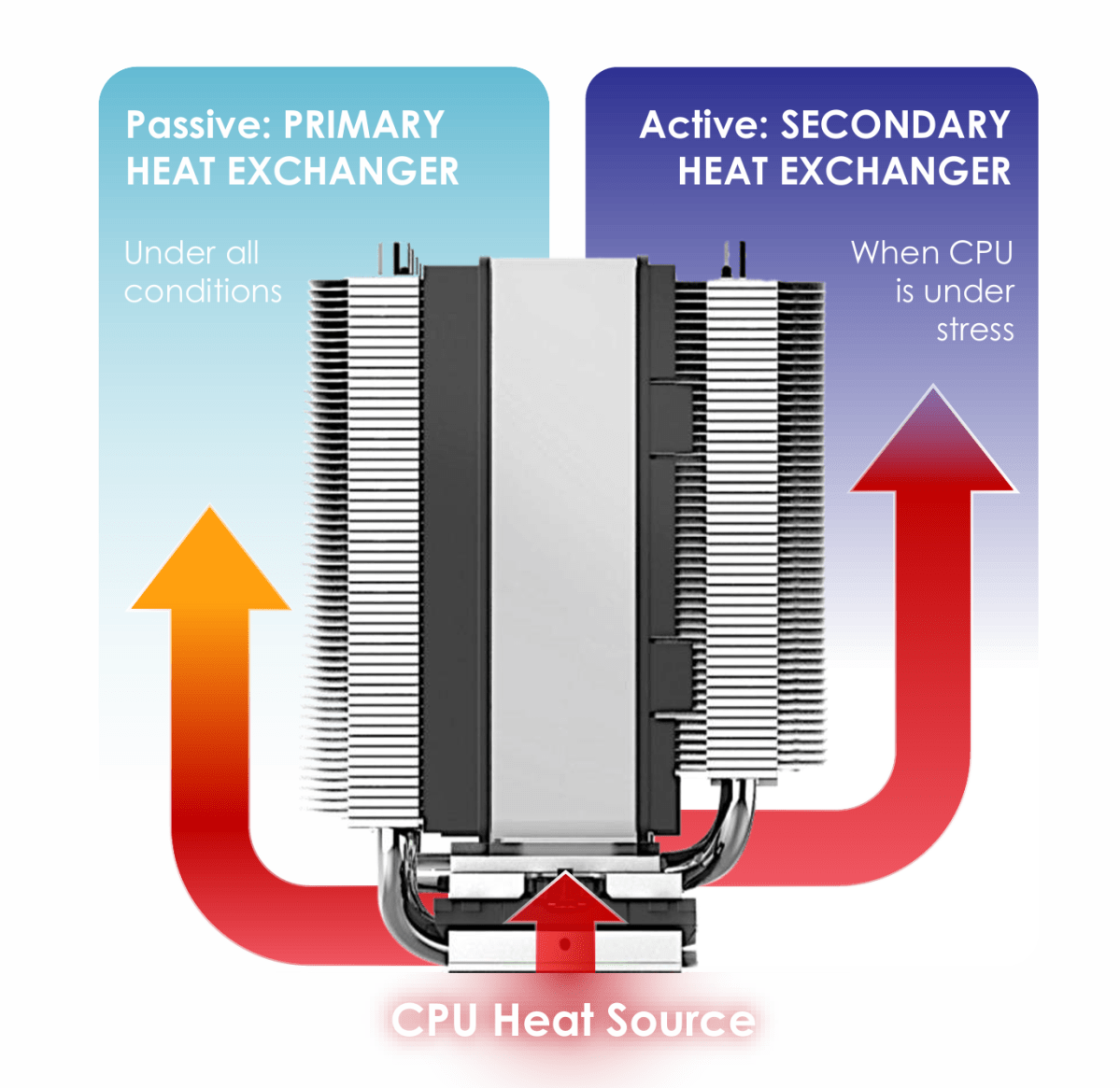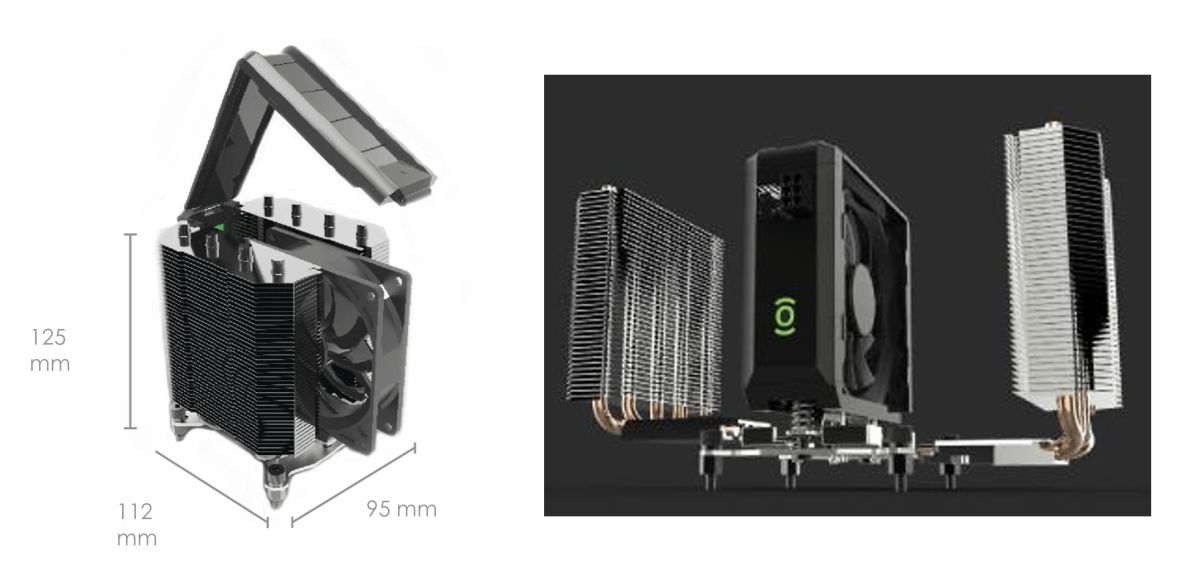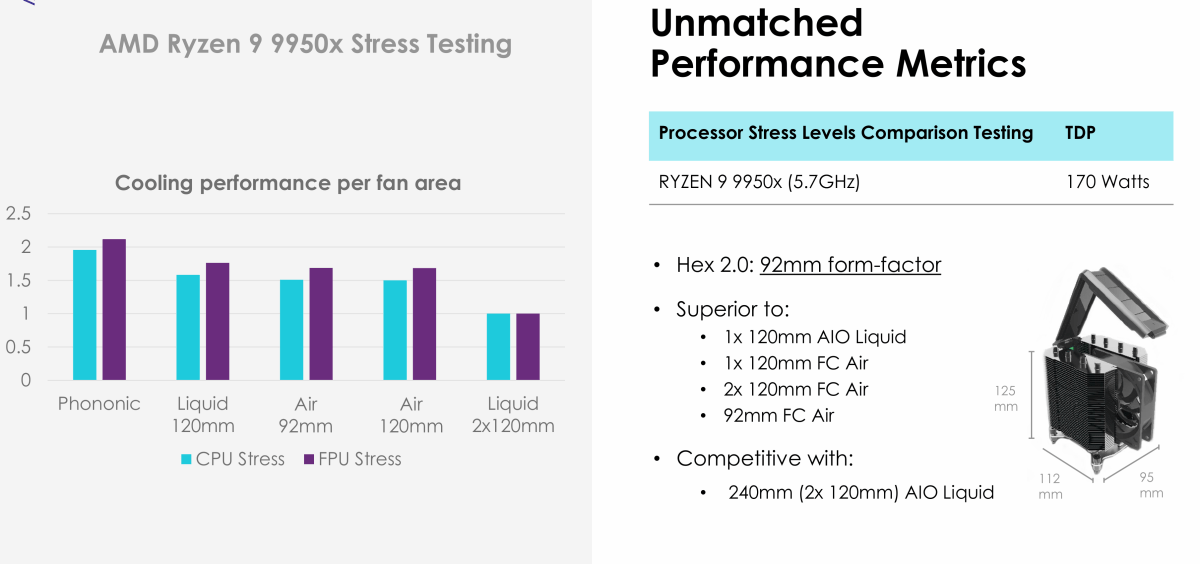
 Image: Phononic
Image: Phononic
A startup, Phononic, says that it has a new twist on what sounds like a Peltier cooler, using electrical energy to cool a processor in a PC or a data center.
Phononic announced the Hex 2.0 CPU cooler at the Hot Chips conference, which is targeting at the data center. The company showed off while using an AMD Ryzen 9950X for stress testing, however. The cooler, in what the company calls a 92mm form factor, is competitive with an all-in-one liquid cooler with a pair of 120mm fans (240mm total) attached, a Phononics executive claimed.
The Hex 2.0 cooler tries to combine both passive cooling and active cooling in the same device. One side is essentially a passive heat sink, with numerous “fins” for cooling. When needed, however, the other side kicks in, with a semiconductor-based cooling solution that uses a heat pump to push heat to a second set of fins, plus a fan to cool those fins and by extension the chip.
Phononic is yet another company using solid-state solutions to help cool chips, after leaning on thermoelectics before. Frore Systems debuted in 2022 with the Frore Airjet, aiming at laptop chips and SSDs. A competitor, xMEMS, has attacked the smartphone and SSD market with a similar, yet smaller solid-state cooling chip, the XMC-2400. Phononic is far from an actual cooling chip itself, but company executives said that they’re using a semiconductor-based solution to help move heat.


Phononic

Phononic
Phononic
If this sounds familiar, it should. Phononic uses the Peltier effect to help move heat, which moves heat by passing electricity thermoelectrically through a thermocouple. Peltier coolers came and went because they faced a problem: it takes electrical power to move the heat around, and that power is in addition to the electrical power consumed by the chip. But Phononic says that it’s worked to eliminate inefficiencies. Interestingly, the same company provides HVAC technology as well as “smart totes” that help preserve the “cold chain” needed in the transportation of temperature-sensitive groceries and food.
In Phononics’ case, the Hex 2.0 chip cooler requires an additional 35W of electrical power to actively manage a chip — in this case, a 170W TDP CPU, the Ryzen 9 9950X. (That chip can ramp up to 230W when operating in turbo mode, however.) “When you don’t need it, there’s zero additional power,” said Jesse Edwards, a distinguished engineer at Phononic, at a Hot Chips seminar.
The problem that Phononic is trying to solve is basically identical to the one Frore and xMEMS are attacking, too: a chip, PC or server operates as fast as possible until it hits a thermal limit, after which safeguards in then chip or system slow down or “throttle” the chip to avoid overheating. If that additional heat can be removed, the chip or system can run as fast as it can.


Phononic

Phononic
Phononic
Passive coolers, such as a heat sink, are silent but can only dissipate so much heat — and they’re capped by the ambient temperature. An active cooler can dissipate more heat, but can produce more noise. The additional cooling is also not always needed.
Phononic is trying for the best of both worlds. The Hex 2.0 cooler measures 125 x 112 x 95mm, and weighs 810 grams. The fan measures 92mm in diameter. It pushes 44 cubic feet per minute of air flow, at 2650 RPM (1,000 RPM at idle). At maximum, it generates 33 dBA of sound.
In its own stress testing of the Ryzen 9950X, the company found it outperformed liquid cooling and air cooling alike, though Edwards said that the active cooling could be connected to a traditional watercooling system as well. The heat pump is “competitive to traditional vapor compression systems with respect to its capacity, performance and costs, and it is extremely compact,” Johnson said, and the devices can be combined together for additional effect, he said.


Phononic

Phononic
Phononic
Phononic isn’t trying to see its devices to the latest generation of data centers, which have been built around water-based cooling, he said. Instead, the company is trying to sell its technology, including the Hex coolers, to older data centers built around air cooling — and, presumably, whatever devices can take advantage of them.
With Be Quiet! and other manufacturers emphasizing low acoustical noise as well as the ability to pump heat away from chips, the market for PC thermal management is heading into different directions. Will Phononic be yet another option, someday, for PC cooling?
Author: Mark Hachman, Senior Editor, PCWorld

Mark has written for PCWorld for the last decade, with 30 years of experience covering technology. He has authored over 3,500 articles for PCWorld alone, covering PC microprocessors, peripherals, and Microsoft Windows, among other topics. Mark has written for publications including PC Magazine, Byte, eWEEK, Popular Science and Electronic Buyers’ News, where he shared a Jesse H. Neal Award for breaking news. He recently handed over a collection of several dozen Thunderbolt docks and USB-C hubs because his office simply has no more room.
Recent stories by Mark Hachman:
New Asus motherboard makes swapping graphics cards so much easierAMD’s Ryzen 9000 patch boosts performance on Windows 11Meet xMEMS, a challenger to AirJet’s radical solid-state chip cooling


